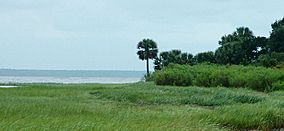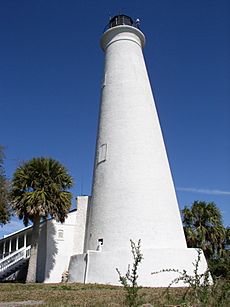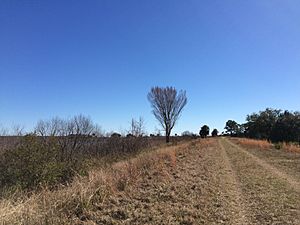St. Marks National Wildlife Refuge facts for kids
Quick facts for kids St. Marks National Wildlife Refuge |
|
|---|---|
|
IUCN Category IV (Habitat/Species Management Area)
|
|

St. Marks National Wildlife Refuge shoreline near Lighthouse
|
|
| Location | Wakulla County, Jefferson County, Taylor County, Florida, United States |
| Nearest city | St. Marks, Florida |
| Area | 68,000 acres (280 km2) |
| Established | 1931 |
| Governing body | U.S. Fish and Wildlife Service |
| Website | St. Marks National Wildlife Refuge |
The St. Marks National Wildlife Refuge is a special place in Florida, United States. It's one of the oldest wildlife refuges in the country. It was created in 1931 to give a safe home to birds that travel long distances for winter.
This huge area covers about 68,000 acres (280 square kilometers). It spreads across three counties: Wakulla, Jefferson, and Taylor.

The refuge has many different natural areas along the Gulf of Mexico. These include salty marshes, islands, small tidal creeks, and places where rivers meet the sea. It's filled with many types of plants and animals. It also has a long history of people living and working there. One famous building is the St. Marks Lighthouse, which is the second oldest lighthouse in Florida.
The St. Marks National Wildlife Refuge is also a main spot on the Great Florida Birding Trail. This trail helps people find the best places to watch birds in Florida.
Contents
Explore the Refuge: Fun Activities
St. Marks National Wildlife Refuge offers many exciting things to do for people who love the outdoors. You can see many different animals here.
Wildlife You Might See
The refuge is home to black bears, bobcats, otters, raccoons, and foxes. You might also spot coyotes, amphibians, and alligators. Many kinds of snakes live here too.
It's a fantastic place for birdwatching. You can see wading birds, shorebirds, waterfowl, and birds of prey. During spring and fall, the number of bird species grows a lot as they stop here on their long journeys.
Fishing and Boating Adventures
If you enjoy fishing, there are many spots to cast your line. You can catch both freshwater and saltwater fish. A boat ramp near the lighthouse lets you get right onto the St. Marks River. From there, you can easily reach the Gulf of Mexico.
Keep in mind that the water level at the boat ramp changes with the tides. Very low tides might make it harder to launch or take out your boat. Kayakers can also launch their boats directly into the Gulf from the lighthouse parking lot.
Trails for Hikers and Cyclists
Hikers and cyclists have miles of trails to explore. These trails go through many different natural areas. There's even a biking trail that is about 20 miles long. It runs from Tallahassee down to the nearby town of St. Marks. This trail follows an old railroad path.
Art and Learning Opportunities
The refuge is a great place for artists. You can sketch, draw, paint, or take photos of the beautiful scenery and wildlife.
The refuge has a large Visitors Center. Here, you can get maps and brochures to help you plan your visit. Inside the center, there's a bookstore with many books and items for sale. Next to the Visitors Center is the Education building. It has comfortable rooms for meetings and staff who focus on teaching visitors about the refuge.
Helping Hands: Volunteers and Partners
Many volunteers help the U.S. Fish and Wildlife Service at the refuge. They assist with research projects and public events. These events include educational field trips, festivals, and historical celebrations.
The St. Marks Refuge Association is a very successful group of friends who support the refuge. There is also a very active Photography Club. Both groups provide many volunteers for the refuge.
Special Visitors: Cranes and Butterflies
The St. Marks National Wildlife Refuge is a special winter home for endangered whooping cranes. These cranes are led south by small aircraft as part of a project called Operation Migration. The project trains young cranes to follow the aircraft. This helps them learn their first migration route.
The refuge is also a stopping point for the yearly monarch butterfly migration. Every October, a festival is held around the time the butterflies pass through. This event teaches people about tagging monarchs as they continue their amazing journey.
The St. Marks National Wildlife Refuge also inspired the setting for author Jeff VanderMeer's Southern Reach Trilogy books.
Wilderness Area
A part of the refuge, called the St. Marks Wilderness, was set aside in 1975. This wilderness area covers 17,350 acres. It is part of the National Wilderness Preservation System in the U.S. The Florida National Scenic Trail goes through the refuge for 41 miles, including a section of this wilderness area.
How to Get There
You can enter the refuge at several public access points:
- Panacea Unit
- Wakulla Unit
- Purify Bay Road, in Medart
- Shell Point Highway, north of Shell Point
- Wakulla Beach Road, east of Shell Point
- St. Marks Unit
- Lighthouse Road, which is the main entrance, in Newport
- Mandalay Bay Road, just east of the Aucilla River in Taylor County.
There is no paved public road to access the refuge in Jefferson County.
Images for kids







